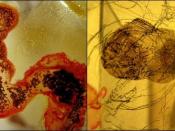Livestock have contributed to human society in a number of ways, both good and bad. "Guns, Germs, and Steel" chapter Lethal Gift of Livestock dealt with some of the negative consequences of keeping livestock in such close proximity. Also, it considered what diseases are, and why they make us ill. As well as why diseases have been spread more effectively in highly populated settings and as a result of the development of agriculture. It also tried to give an explanation for the almost one-way transfer of diseases for the Old World to the New World.
Epidemic diseases tend to produce no cases for a long time, then there may be a wave of new cases, followed by no more cases again for a time. Since many of these diseases are restricted to humans, microbes causing these diseases are not normally found in the soil or other animals.
They spread quickly through a population resulting in an entire healthy population becoming exposed with the infected person either recovering completely or dying within a short period of time. Those who recover develop antibodies that prevent becoming ill with that disease in the future. Some humans may have a genetic advantage that makes them resistant to a certain pathogen. In epidemic those with genetic resistance are more likely to survive and pass their genes on to future generation. This allows for populations to become better protected against a disease as a whole. However, many of these microbes have been able to evolve allowing for resistance which has resulted in a continuous battle between us and microbes.
To sustain epidemics, microbes need a human population that is quite substantial and live in close enough proximity to continue the spread of the disease. These diseases, called crowd disease, need dense populations and...


